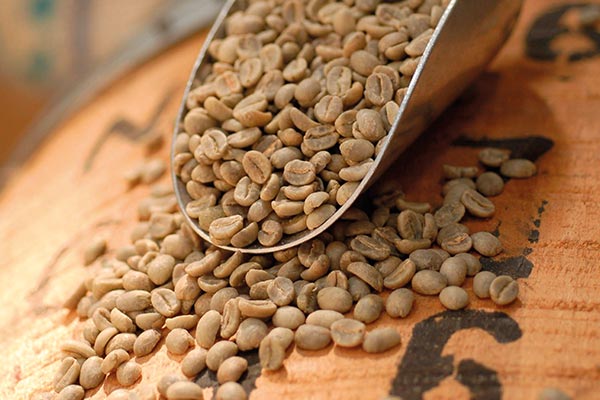The species
Although there are over 60 species of coffee in the world, the berries used to prepare the beverage come from only two species: Coffea arabica, approximately 75%, and Coffea robusta, 25%.
Arabica
Despite the name, this variety of coffee plant originated in Ethiopia and represents 75% of the world coffee production. Currently, Brazil is the largest Arabica coffee producer in the world, followed by several other Latin American countries. The beans have a typical green-blue and yellow-green colour and an elongated shape. Regarding the taste and aroma, Arabica produces an aromatic, sweet and delicate coffee and is characterized by a low caffeine content, between 0.8 and 1.5%.
Robusta
As with the Arabica variety, Robusta plants prefer the equatorial zones of the planet and trace their origins to Central Africa. Currently, this variety is primarily cultivated in tropical Asiatic regions, Vietnam in particular, as well as tropical African regions and Brazil. More productive, hardier and quicker to ripen, Robusta plants produce roundish beans that are yellow or yellow-brown in colour. Compared to Arabica, this variety produces a coffee that is more full-bodied, bitter and has a caffeine content that varies between 1.7 and 3.5%.
The plant

The coffee plant is an evergreen shrub belonging to the Rubiaceae family of the genus Coffea, with shiny, dark-green, pointed leaves and white blossoms that have an intense perfume reminiscent of jasmine. The green, cherry-shaped fruit turn red when they have fully ripened. There are two beans inside every drupe; these are flat on the interior side where the beans touch, are separated by a groove and have convex exteriors. In some cases, when the fruit grows at the end of the branch, only a single round bean, called a peaberry or caracoli, develops inside the drupe.
The production zones
The principal area where coffee plantations have been developed is known as the “coffee-growing region”, which lies between the 30th parallel south and the equator. This part of the planet is the most ideal location for cultivating the delicate coffee plant because the average temperature ranges between 18 and 24°C, thereby eliminating the threats of frost or excessive heat. Altitude is another very important factor for the plant’s cultivation: the Arabica variety grows at an altitude of between 900 and 2000 metres, the Jamaica Blue Mountain varietal is cultivated at 2500 metres, and the Robusta variety grows at altitudes ranging from 200 to 600 metres.

Cultivation

An excellent cup of coffee is the result of a long and careful process that begins with the very first phases of the plant’s growth. The plants do not begin producing until they are three of four years old; during these early years they are pruned and watered frequently. After the coffee plants are planted in deep, permeable and neutral or slightly acidic soil, they are given constant, attentive care.
The harvest
There are two harvesting methods: picking and stripping. The first method, which is completely manual, consists of harvesting only the red, and therefore completely ripe, cherries from the coffee plant. This method is very expensive, of course, but it guarantees a decidedly high average quality for the product. Stripping, on the other hand, consists of a much faster process in which entire clusters of ripened berries are removed, either by hand or with appropriate machinery. On the ground, the beans are collected and placed in baskets; however, there is a higher risk of also gathering unripe or overripe beans than in the picking method. Once harvested, the beans are separated from the pulp, using either the dry method or the wet method. The dry method is the process used to obtain “natural” coffees and consists of drying the cherries in the sun for several days. After the required amount of time for complete drying has passed, the drupes are pulped with appropriate machinery, removing the skin and the dry pulp.
The wet method, which is lengthier and more costly, produces what is known as “washed” coffee. However, this system requires the availability of large quantities of water to wet the sieves through which the fruit is passed to remove the pulp. After passing through these sieves, the beans are placed in fermentation tanks. When the fermentation process is complete, the beans are washed and then dried either mechanically or in the sun. Once dry, the beans are milled to remove the parchment and reveal the green coffee bean

The harvest

As the quality of the coffee is the primary feature that distinguishes Hausbrandt, the company has adopted a rigorous inspection and quality control system. The company has many mechanisms in place to guarantee the highest level of quality, including bi-chromatic sorting. Over a distance of just 10 cm, every single Arabica bean is analyzed 30 times by photocells that can recognize and remove unripe, tough or fermented beans that could compromise the quality of the final product. This is followed by the washing, polishing, and selecting of the Robusta beans; these steps eliminate foreign flavours, toughness and taste defects that could alter the characteristics of the coffee’s body. Hausbrandt technicians constantly monitor every single step of the selection process so that only the very best coffee beans, in excellent condition, go on to be roasted.


